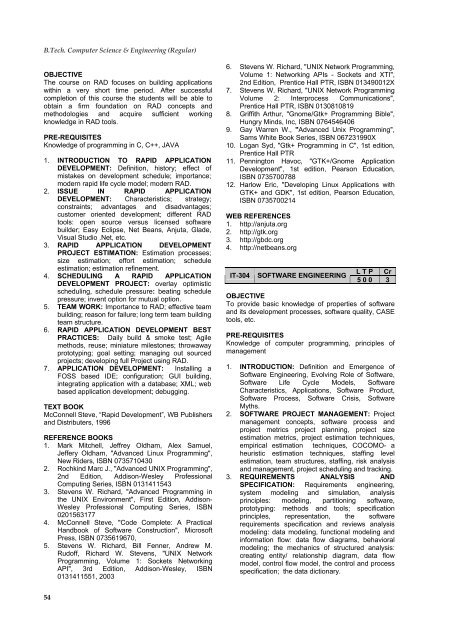B.Tech. Degree Programme Computer Science & Engineering
B.Tech. Degree Programme Computer Science & Engineering
B.Tech. Degree Programme Computer Science & Engineering
Create successful ePaper yourself
Turn your PDF publications into a flip-book with our unique Google optimized e-Paper software.
B.<strong>Tech</strong>. <strong>Computer</strong> <strong>Science</strong> & <strong>Engineering</strong> (Regular)OBJECTIVEThe course on RAD focuses on building applicationswithin a very short time period. After successfulcompletion of this course the students will be able toobtain a firm foundation on RAD concepts andmethodologies and acquire sufficient workingknowledge in RAD tools.PRE-REQUISITESKnowledge of programming in C, C++, JAVA1. INTRODUCTION TO RAPID APPLICATIONDEVELOPMENT: Definition, history; effect ofmistakes on development schedule; importance;modern rapid life cycle model; modern RAD.2. ISSUE IN RAPID APPLICATIONDEVELOPMENT: Characteristics; strategy;constraints; advantages and disadvantages;customer oriented development; different RADtools: open source versus licensed softwarebuilder; Easy Eclipse, Net Beans, Anjuta, Glade,Visual Studio .Net, etc.3. RAPID APPLICATION DEVELOPMENTPROJECT ESTIMATION: Estimation processes;size estimation; effort estimation; scheduleestimation; estimation refinement.4. SCHEDULING A RAPID APPLICATIONDEVELOPMENT PROJECT: overlay optimisticscheduling, schedule pressure: beating schedulepressure; invent option for mutual option.5. TEAM WORK: Importance to RAD; effective teambuilding; reason for failure; long term team buildingteam structure.6. RAPID APPLICATION DEVELOPMENT BESTPRACTICES: Daily build & smoke test; Agilemethods, reuse; miniature milestones; throwawayprototyping; goal setting; managing out sourcedprojects; developing full Project using RAD.7. APPLICATION DEVELOPMENT: Installing aFOSS based IDE; configuration; GUI building,integrating application with a database; XML; webbased application development; debugging.TEXT BOOKMcConnell Steve, “Rapid Development”, WB Publishersand Distributers, 1996REFERENCE BOOKS1. Mark Mitchell, Jeffrey Oldham, Alex Samuel,Jeffery Oldham, "Advanced Linux Programming",New Riders, ISBN 07357104302. Rochkind Marc J., "Advanced UNIX Programming",2nd Edition, Addison-Wesley ProfessionalComputing Series, ISBN 01314115433. Stevens W. Richard, "Advanced Programming inthe UNIX Environment", First Edition, Addison-Wesley Professional Computing Series, ISBN02015631774. McConnell Steve, "Code Complete: A PracticalHandbook of Software Construction", MicrosoftPress, ISBN 0735619670,5. Stevens W. Richard, Bill Fenner, Andrew M.Rudoff, Richard W. Stevens, "UNIX NetworkProgramming, Volume 1: Sockets NetworkingAPI", 3rd Edition, Addison-Wesley, ISBN0131411551, 20036. Stevens W. Richard, "UNIX Network Programming,Volume 1: Networking APIs - Sockets and XTI",2nd Edition, Prentice Hall PTR, ISBN 013490012X7. Stevens W. Richard, "UNIX Network ProgrammingVolume 2: Interprocess Communications",Prentice Hall PTR, ISBN 01308108198. Griffith Arthur, "Gnome/Gtk+ Programming Bible",Hungry Minds, Inc, ISBN 07645464069. Gay Warren W., "Advanced Unix Programming",Sams White Book Series, ISBN 067231990X10. Logan Syd, "Gtk+ Programming in C", 1st edition,Prentice Hall PTR11. Pennington Havoc, "GTK+/Gnome ApplicationDevelopment", 1st edition, Pearson Education,ISBN 073570078812. Harlow Eric, "Developing Linux Applications withGTK+ and GDK", 1st edition, Pearson Education,ISBN 0735700214WEB REFERENCES1. http://anjuta.org2. http://gtk.org3. http://gbdc.org4. http://netbeans.orgIT-304SOFTWARE ENGINEERINGL T P Cr5 0 0 3OBJECTIVETo provide basic knowledge of properties of softwareand its development processes, software quality, CASEtools, etc.PRE-REQUISITESKnowledge of computer programming, principles ofmanagement1. INTRODUCTION: Definition and Emergence ofSoftware <strong>Engineering</strong>, Evolving Role of Software,Software Life Cycle Models, SoftwareCharacteristics, Applications, Software Product,Software Process, Software Crisis, SoftwareMyths.2. SOFTWARE PROJECT MANAGEMENT: Projectmanagement concepts, software process andproject metrics project planning, project sizeestimation metrics, project estimation techniques,empirical estimation techniques, COCOMO- aheuristic estimation techniques, staffing levelestimation, team structures, staffing, risk analysisand management, project scheduling and tracking.3. REQUIREMENTS ANALYSIS ANDSPECIFICATION: Requirements engineering,system modeling and simulation, analysisprinciples: modeling, partitioning software,prototyping: methods and tools; specificationprinciples, representation, the softwarerequirements specification and reviews analysismodeling: data modeling, functional modeling andinformation flow: data flow diagrams, behavioralmodeling; the mechanics of structured analysis:creating entity/ relationship diagram, data flowmodel, control flow model, the control and processspecification; the data dictionary.54
















